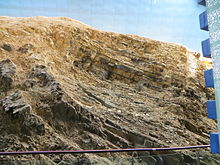Sedimentum Chengjiangense
(Redirectum de Sedimentum Chengjiangensis)
Sedimentum fossile Chengjiangense[1][2] sive Anglice Chengjiang fossil site[3] est sedimentum apothecarium, pars schistorum Maotianshanensium et membrum formationis Qiongzhusiensis in Iunnania Sinarum.


E sedimentis singulis Chengjiangensibus, videlicet Shankoucun, Mafangcun, Meishucun, Sanjiezi, Ercaicun, Xiaolantian, Maotianshan, Haociyun,[4] fossilia multa et varia periodi Cambriae inferioris (seriei 2 et stadii 3 nondum nominatorum), mirabiliter conservata, effossa sunt, inter quae:

Sedimentum Guanshanense paulo recentius, in eadem regione repertum, stadio Cambrio 4 attribuitur.
Notae
recensere- ↑ Haec appellatio a Vicipaediano e lingua indigena in sermonem Latinum conversa est. Extra Vicipaediam huius locutionis testificatio vix inveniri potest.
- ↑ "Chengjiangensis": de verbo adiectivo cf. nomina biologica e.g. Lingulella chengjiangensis
- ↑ A principio sub nomine "Shankou village" definitum, vide Chen et al. (2003); Fossilworks
- ↑ Feiyang Chen et al., "First report on Guanshan Biota (Cambrian Stage 4) at the stratotype area of Wulongqing Formation in Malong County, Eastern Yunnan, China" in Geoscience Frontiers vol. 10 (2019) pp. 1459-1476, vide tabulam 1
Bibliographia
recensere- Jean-Bernard Caron, Simon Conway Morris, Degan Shu, "Tentaculate Fossils from the Cambrian of Canada (British Columbia) and China (Yunnan) Interpreted as Primitive Deuterostomes" in PLOS One (8 Martii 2010)
- J.-Y. Chen et al., "The first tunicate from the Early Cambrian of South China" in Proceedings of the National Academy of Sciences vol. 100 (2003) pp. 8314-8318 alibi
- J. W. Hagadorn, "Chengjiang: Early record of the Cambrian explosion" in David J. Bottjer et al., Exceptional fossil preservation : a unique view on the evolution of marine life (Novi Eboraci: Columbia University Press, 2002) pp. 35-60
- Jian Han, Zhifei Zhang, Jianni Liu, Degan Shu, "Evidence of Priapulid Scavenging from the Early Cambrian Chengjiang Deposits, Southern China" in Palaios vol. 22 (2007) pp. 691-694
- Hou Xian‐Guang, Jan Bergström, Per Ahlberg, "Anomalocaris and other large animals in the Lower Cambrian Chengjiang fauna of southwest China" in GFF vol. 117 (1995) pp. 163-183
- Hou Xian-Guang et al., The Cambrian Fossils of Chengjiang, China: The Flowering of Early Animal Life. Wiley, 2017 (Paginae selectae apud Google Books)
- Shixue Hu, Michael Steiner, Maoyan Zhu, Bernd-Dietrich Erdtmann, Huilin Luo, Liangzhong Chen, Bernd Weber, "Diverse pelagic predators from the Chengjiang Lagerstätte and the establishment of modern-style pelagic ecosystems in the early Cambrian" in Palaeogeography, Palaeoclimatology, Palaeoecology vol. 254 (2007) pp. 307–316 (imaginem vides p. 309 tab. 1 J)
- Chen Liangzhong et al., edd., 云南东部早寒武世澄江动物群 = Early Cambrian Chengjiang Fauna in Eastern Yunnan, China (Kunming: Yunnan Science and Technology Press, 2002) de hoc libro
- D.-G. Shu et al., "Lower Cambrian Vertebrates from South China" in Nature vol. 402 (1999) pp. 42–46
- J. Vannier, D.C. García-Bellido, S.-X. Hu, A.-L. Chen, "Arthropod visual predators in the early pelagic ecosystem: evidence from the Burgess Shale and Chengjiang biotas" in Proceedings of the Royal Society B: Biological Sciences vol. 276 (2009) pp. 2567-2574
- Xingliang Zhang, Wei Liu, Yuanlong Zhao, "Cambrian Burgess Shale-type Lagerstätten in South China: Distribution and significance" in Gondwana Research vol. 14 (2008) pp. 255–262
- Fangchen Zhao et al., "Spatial variation in the diversity and composition of the Lower Cambrian (Series 2, Stage 3) Chengjiang Biota, Southwest China" in Palaeogeography, Palaeoclimatology, Palaeoecology vol. 346-347 (2012) pp. 54–65
Nexus externi
recensere- "Shankou Village (Maotianshan Shale: Cambrian of China), also known as Chengjiang biota[nexus deficit]" apud Fossilworks
- "Chengjiang Fossil Site" apud Unesco
- "Chengjiang Maotianshan Shales" apud Fossil Museum
- "Chengjiang Biota" apud Fossil Museum